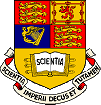
A Robot Zoo
I have been involved with a large number of robot related activities, a number of which are shown below:
![]()
Industrial Networking for FMS Control
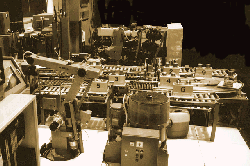 This photograph shows an test set up for a
computer controlled Flexible Manufacturing System (FMS) established at Cranfield to test a protocol conversion unit. The
set-up included a CNC lathe and milling machine, each fed by a robot, an ASEA manipulator for the lathe and
Cincinnatti-Milacron for the milling machine. Materials were passed between the various
stations using a mechanical conveyer system. The protocol conversion unit was later
marketed by Texas Instruments as UNILINK (IMechE abstract, INRIA
abstract, ISATA abstract).
This photograph shows an test set up for a
computer controlled Flexible Manufacturing System (FMS) established at Cranfield to test a protocol conversion unit. The
set-up included a CNC lathe and milling machine, each fed by a robot, an ASEA manipulator for the lathe and
Cincinnatti-Milacron for the milling machine. Materials were passed between the various
stations using a mechanical conveyer system. The protocol conversion unit was later
marketed by Texas Instruments as UNILINK (IMechE abstract, INRIA
abstract, ISATA abstract).
![]()
The "Pumarist" Manipulator Sensor System
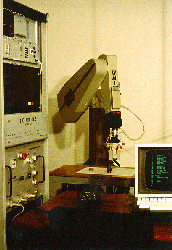 This experimental set-up transferred much of the
sensor system from QMW Mk. 5 robot onto a Unimation PUMA robot. Force sensing was provided
in the X, Y and rotational modes, range sensing by ultrasonic sonar and infrared object
sensing across the gripper jaws; adapted from the Mk. 5 proximity sensing circuits, Close-up of Gripper (101k). Sensor information was processed
by a 8-bit µ-processor and fed to the I/O module of the PUMA controller. This then
integrated with the VAL programming language supplied with the manipulator.
This experimental set-up transferred much of the
sensor system from QMW Mk. 5 robot onto a Unimation PUMA robot. Force sensing was provided
in the X, Y and rotational modes, range sensing by ultrasonic sonar and infrared object
sensing across the gripper jaws; adapted from the Mk. 5 proximity sensing circuits, Close-up of Gripper (101k). Sensor information was processed
by a 8-bit µ-processor and fed to the I/O module of the PUMA controller. This then
integrated with the VAL programming language supplied with the manipulator.
![]()
The QMW Mk. VI Mobile Research Robot
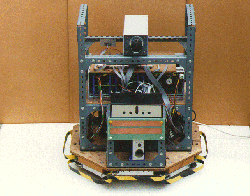 This research robot vehicle replaced and extended the capabilities of the
QMW Mk. 4 robot. Drive was provided by a pair of stepper motors, centrally placed this
time. Power from a 12-volt automotive accumulator, or alternatively a 300W switched mode
power supply. Forward facing contact plates allow recharging. Sensor capabilities included
improved contact sensing, higher resolution sonar rangefinding and improved colour
photo-receptors and additional angled monochrome photo-receptors. A standard 625-line CCTV
camera provided rudimentary vision capabilities. This machine was used to provide rangefinder map information, used as input to a parallel
algorithm for route planning (abstract). Capabilities
such as these may be purchased from companies such as I.S. Robotics Inc., Real World Interface and Nomadic
Technologies. K-Team produce a natty line in miniaturised robots, the Khepera.
This research robot vehicle replaced and extended the capabilities of the
QMW Mk. 4 robot. Drive was provided by a pair of stepper motors, centrally placed this
time. Power from a 12-volt automotive accumulator, or alternatively a 300W switched mode
power supply. Forward facing contact plates allow recharging. Sensor capabilities included
improved contact sensing, higher resolution sonar rangefinding and improved colour
photo-receptors and additional angled monochrome photo-receptors. A standard 625-line CCTV
camera provided rudimentary vision capabilities. This machine was used to provide rangefinder map information, used as input to a parallel
algorithm for route planning (abstract). Capabilities
such as these may be purchased from companies such as I.S. Robotics Inc., Real World Interface and Nomadic
Technologies. K-Team produce a natty line in miniaturised robots, the Khepera.
![]()
The QMW Mk. V Tele-operator Robot
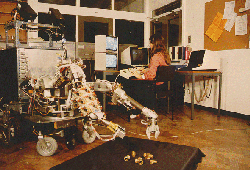 The Mark 5
tele-operator robot sported a pair of
seven degree-of-freedom manipulators mounted on a substantial mobile platform. The
operator moved the vehicle via a control panel and by speech input. Feedback was provided
by multiple closed-circuit television cameras and from instrumentation attached to the
gripper and forearm of the manipulator, ( Close-up of
manipulator, 120k). The forearm was clad in a prototype proximity sensing
"skin", the gripper a combination of sensors including range and contact sensing
(abstract). This work was conducted in collaboration
with the UKAEA, Harwell and ICL Research
Centre, Stevenage and was in large part
funded by the SERC (EPSRC).
The Mark 5
tele-operator robot sported a pair of
seven degree-of-freedom manipulators mounted on a substantial mobile platform. The
operator moved the vehicle via a control panel and by speech input. Feedback was provided
by multiple closed-circuit television cameras and from instrumentation attached to the
gripper and forearm of the manipulator, ( Close-up of
manipulator, 120k). The forearm was clad in a prototype proximity sensing
"skin", the gripper a combination of sensors including range and contact sensing
(abstract). This work was conducted in collaboration
with the UKAEA, Harwell and ICL Research
Centre, Stevenage and was in large part
funded by the SERC (EPSRC).
![]()
The QMW Mk. IV Mobile Research Robot
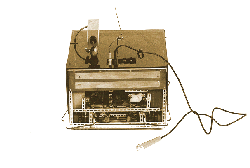 The
final version (Mk. 4) of our first attempts at a mobile robot for machine
learning research. It had a somewhat unusual (and not entirely satisfactory)
drive layout with wheels at the front of the vehicle. D.C. motor drive was
complemented with gray-code shaft encoders. Forward facing sensors included
sonar rangefinder, colour photo-receptors and a 32x32 binary camera. Other
sensors were all round touch bars and battery level monitoring. The contacts
at the top of the front face allowed the vehicle to nestle against a charger
pad. This robot had no on-board computing(!), relying on communications via
an umbilical wire to a DEC PDP-11. The machine was programmed to give a
plausible emulation of the Pavlovian conditioned reflex; and was used
extensively by D.H. Mott in his thesis "Sensory-motor Learning in a
Mobile Robot", an investigation into Piagetian forms of learning.
Despite its simplicity this robot made several television appearances and
enjoyed considerable press coverage.
The
final version (Mk. 4) of our first attempts at a mobile robot for machine
learning research. It had a somewhat unusual (and not entirely satisfactory)
drive layout with wheels at the front of the vehicle. D.C. motor drive was
complemented with gray-code shaft encoders. Forward facing sensors included
sonar rangefinder, colour photo-receptors and a 32x32 binary camera. Other
sensors were all round touch bars and battery level monitoring. The contacts
at the top of the front face allowed the vehicle to nestle against a charger
pad. This robot had no on-board computing(!), relying on communications via
an umbilical wire to a DEC PDP-11. The machine was programmed to give a
plausible emulation of the Pavlovian conditioned reflex; and was used
extensively by D.H. Mott in his thesis "Sensory-motor Learning in a
Mobile Robot", an investigation into Piagetian forms of learning.
Despite its simplicity this robot made several television appearances and
enjoyed considerable press coverage.
![]()
A Simulation of Klino-kinesis
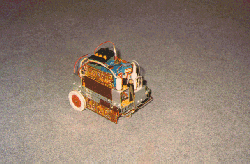 This minature robot was inspired by
W.
Grey Walter's light seeking Machina
Speculartrix, but was designed to give a true simulation of various animal movement
and orientation strategies. Three strategies were emulated, klinotaxis (as seen in the
larval stage of the common fly Musca), orthokinesis (documented for the woodlouse Porcello
scaber) and klinokinesis (emulating the planarian Dendrocoelum). The robot was
adapted to each strategy by installing the appropriate hard-wired circuit card (seen on
the true right of the vehicle in the photograph). Note on-going work by Barbara Webb on phonotaxis
(orientation to sound) in the cricket.
This minature robot was inspired by
W.
Grey Walter's light seeking Machina
Speculartrix, but was designed to give a true simulation of various animal movement
and orientation strategies. Three strategies were emulated, klinotaxis (as seen in the
larval stage of the common fly Musca), orthokinesis (documented for the woodlouse Porcello
scaber) and klinokinesis (emulating the planarian Dendrocoelum). The robot was
adapted to each strategy by installing the appropriate hard-wired circuit card (seen on
the true right of the vehicle in the photograph). Note on-going work by Barbara Webb on phonotaxis
(orientation to sound) in the cricket.
![]()